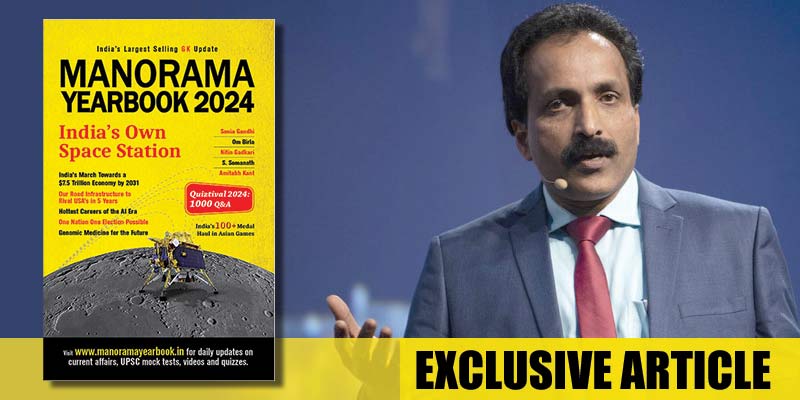- India
- Dec 13
ISRO plans to put first Indian astronaut on Moon by 2040
In an exclusive article for Manorama Yearbook 2024, ISRO chairman S. Somanath said the space agency is going full throttle with its plans to send Indian astronauts for the first time to the Moon by 2040.
Somanath also said that Prime Minister Narendra Modi has set ambitious goals such as commissioning ‘Bharatiya Antariksha Station’ (Indian Space Station) by 2035, and embarking on interplanetary exploration, featuring a Venus Orbiter Mission and a Mars Lander, to further solidify India’s presence on the global space stage.
In 2023, the Indian Space Research Organisation (ISRO) scripted history with the success of the Chandrayaan-3 mission. Chandrayaan-3’s Lander Module touched down on the lunar South Pole on August 23, making it the first country to land on the uncharted surface.
Aditya-L1, India’s maiden solar exploratory mission, was launched in September. It will study the Sun from the unique vantage point of Lagrange Point 1. Aditya-L1 is poised for a five-year mission. The spacecraft is on its intended path towards Sun-Earth Lagrange Point 1(L1), approximately 1.5 million km from Earth, where it will be inserted into a Halo orbit in January 2024.
Gaganyaan mission
• ISRO is currently working on the country's maiden manned mission, ‘Gaganyaan’.
• ISRO is planning to launch a crew of two to three Indian astronauts into Low Earth Orbit (LEO) for up to three days before safely returning them to a predefined site in Indian waters.
• Four pilots from the Indian Air Force who were selected for the mission are undergoing training at the Astronaut Training Facility in Bengaluru.
• The inaugural manned space mission Gaganyaan involves developing critical technologies, including a human-rated (capable of safely transporting humans) launch vehicle (LVM3), an Orbital Module comprising a Crew Module (CM) and Service Module (SM), and life support systems.
• Two identical uncrewed missions (G1 & G2) besides Integrated Air Drop Test, Pad Abort Test, and Test Vehicle flights will precede the manned mission.
• The Crew Module is a habitable space with an Earth-like environment in space for the crew and is designed for safe re-entry. Safety measures also include a Crew Escape System (CES) for emergencies.
• The first development flight of Test Vehicle (TV-D1) was launched on October 21, 2023, and it successfully demonstrated in-flight abort of the Crew Escape System, followed by Crew Module separation and its safe recovery from the Bay of Bengal by the Indian Navy.
Other upcoming missions
• Somanath said other ambitious ongoing and upcoming missions include Small Satellite Launch Vehicle (SSLV) and Reusable Launch Vehicle (RLV) programme, XPoSat (X-ray Polarimeter Satellite) mission, Space Docking Experiment, and LOX-Methane engine.
• Planned to launch in 2024, XPoSat is India’s first dedicated science mission which will investigate bright astronomical X-ray sources in extreme conditions by using scientific payloads.
• SPADEX (Space Docking Experiment), planned for launch in the third quarter of 2024, is a twin spacecraft mission dedicated to advancing docking and formation flying technologies, with a scope of applications in human spaceflight. The mission involves two mini-satellites — one designated as a Chaser and the other as a Target, launched together as co-passengers. The success of the docking experiment holds significant importance in paving the way for lunar sample return missions under future Chandrayaan missions.
• Equally significant is the ongoing development of ‘LOX methane’ (liquid oxygen oxidiser and methane fuel) engines, which is a game changer in future technology. It holds the potential to facilitate human exploration of environments on other planets, such as Mars. Methane is a potential space fuel that can be synthesized using water and carbon dioxide in space.
(The full article by ISRO chief S. Somanath is available in the newly released Manorama Yearbook 2024)

